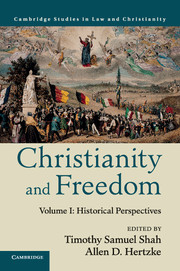Book contents
- Frontmatter
- The Religious Freedom Research Project
- Contents
- Contributing Authors
- Acknowledgments
- Introduction: Christianity and Freedom: Ancient Roots and Historical Innovations
- 1 The Roots of Religious Freedom in Early Christian Thought
- 2 The Christian Roots of Religious Freedom
- 3 Lactantius on Religious Liberty and His Influence on Constantine
- 4 Augustine and Religious Freedom
- 5 Christianity and the Roots of Human Dignity in Late Antiquity
- 6 Liberty of Conscience and Freedom of Religion in the Medieval Canonists and Theologians
- 7 Faith, Liberty, and the Defense of the Poor: Bishop Las Casas in the History of Human Rights
- 8 Calvinist Contributions to Freedom in Early Modern Europe
- 9 Constitutional Protection of the Freedom of Conscience in Colonial America: The Rhode Island and Pennsylvania Experiments
- 10 Christianity and Freedom in the American Founding
- 11 Vibrant Christian Pluralism and the Evolution and Defense of Religious Liberty in America
- 12 Orthodox Christian Contributions to Freedom: Historical Foundations, Contemporary Problematics
- 13 Christianity: A Straggler on the Road to Liberty?
- 14 Protestant Missionaries and the Centrality of Conversion Attempts for the Spread of Education, Printing, Colonial Reform, and Political Democracy
- 15 God and Freedom: Biblical Roots of the Western Idea of Liberty
- Index
Introduction: Christianity and Freedom: Ancient Roots and Historical Innovations
Published online by Cambridge University Press: 05 May 2016
- Frontmatter
- The Religious Freedom Research Project
- Contents
- Contributing Authors
- Acknowledgments
- Introduction: Christianity and Freedom: Ancient Roots and Historical Innovations
- 1 The Roots of Religious Freedom in Early Christian Thought
- 2 The Christian Roots of Religious Freedom
- 3 Lactantius on Religious Liberty and His Influence on Constantine
- 4 Augustine and Religious Freedom
- 5 Christianity and the Roots of Human Dignity in Late Antiquity
- 6 Liberty of Conscience and Freedom of Religion in the Medieval Canonists and Theologians
- 7 Faith, Liberty, and the Defense of the Poor: Bishop Las Casas in the History of Human Rights
- 8 Calvinist Contributions to Freedom in Early Modern Europe
- 9 Constitutional Protection of the Freedom of Conscience in Colonial America: The Rhode Island and Pennsylvania Experiments
- 10 Christianity and Freedom in the American Founding
- 11 Vibrant Christian Pluralism and the Evolution and Defense of Religious Liberty in America
- 12 Orthodox Christian Contributions to Freedom: Historical Foundations, Contemporary Problematics
- 13 Christianity: A Straggler on the Road to Liberty?
- 14 Protestant Missionaries and the Centrality of Conversion Attempts for the Spread of Education, Printing, Colonial Reform, and Political Democracy
- 15 God and Freedom: Biblical Roots of the Western Idea of Liberty
- Index
Summary
On Sunday, February 15, 2015, the Islamic State (IS) released a video that showed masked members of a newly formed branch of the militant group in Libya beheading twenty-one Coptic Christians on a beach near Tripoli. Under the title “A Message Signed with Blood to the Nation of the Cross,” the video included remarks by a lead executioner – speaking in fluent English with an American accent – who underscored that he and his fellow religious warriors were fighting proudly under the banner of the Islamic State group. They were intent on avenging the killing of “Sheikh” Osama bin Laden, he said, and on expanding the war against the “cross” that IS began in Syria. “O, people, recently you have seen us on the hills of as-Sham and Dabiq's plain, chopping off the heads that have been carrying the cross for a long time,” the fighter said, using Arabic terms for places in and around Syria. “Today, we are on the south of Rome, on the land of Islam, Libya, sending another message.” The captives are made to kneel in the sand, and then, according to the account by the New York Times, “they are simultaneously beheaded with the theatrical brutality that has become the trademark of Islamic State extremists.”
A day after the release of the video, “Rome” responded. Speaking in fact from Rome (or Vatican City, technically), the man personifying the “Rome” of the Islamic State's imagination, Pope Francis, head of the Roman Catholic Church and undoubtedly the world's most well-recognized and influential Christian leader, expressed his “profound sorrow” about the beheadings. “Today, I read about the execution of those twenty-one or twenty-two Coptic Christians,” he announced, in off-the-cuff remarks delivered in his native Spanish. “Their only words were: ‘Jesus, help me!’ They were killed simply for the fact that they were Christians…. The blood of our Christian brothers and sisters is a testimony which cries out to be heard.” In an extended departure from a prepared speech he was delivering to representatives of the Church of Scotland, he continued: “It makes no difference whether they be Catholics, Orthodox, Copts or Protestants. They are Christians! Their blood is one and the same. Their blood confesses Christ.
- Type
- Chapter
- Information
- Christianity and Freedom , pp. 1 - 32Publisher: Cambridge University PressPrint publication year: 2016



